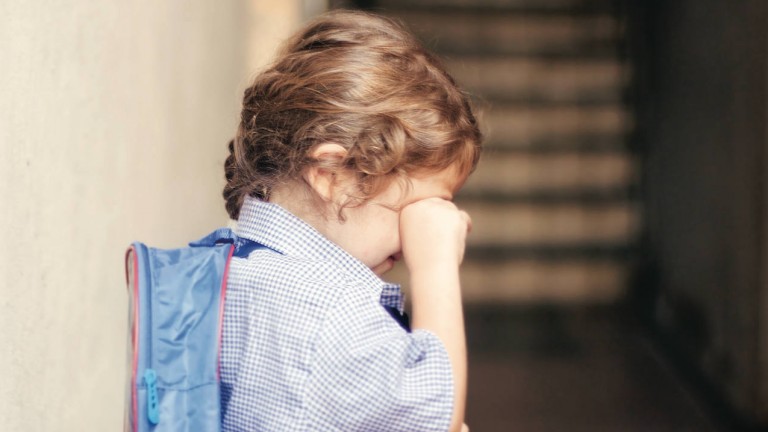Crying at drop-off is quite common for three-and four-year-olds. Here are some ways you can help your kid feel a little happier at goodbye.

Photo: Getty Images
For Jill Hancock,* dropping her three-year-old son off at daycare followed a painful pattern. “Everything would be fine as we walked in, but as soon as I tried to hand him over to the teacher, he’d start clinging to me and crying,” she says. When preschool (or the preschool room at daycare) is new to kids, crying at drop-off is common for the first couple of weeks, but for Hancock, it went on for months and months on end. “It was never a full-on panicked freak-out, but he’d cry and cling every time,” says Hancock. “It felt like a bad way for him—and for me—to start the day. It seemed like he’d never get used to it.”
The fact is, some preschoolers have a harder time adjusting to change than others, and they’ll protest any change with tears. “Some kids just have a personality that’s overly cautious or slow to open up to new situations,” says Jaquie Nickoriuk, a psychologist with Aspire Special Needs Resource Centre in Red Deer, Alta. “It’s normal.”
Although most kids will calm down and have a perfectly fun time once mom or dad makes an exit, beginning the day this way can break a parent’s heart. If you’re dealing with a particularly stubborn case of separation anxiety that doesn’t seem to be getting any better, here are a few things to try.
1. Go through the steps
Knowing exactly what’s coming up helps kids feel more relaxed and prepared. “Tell them, ‘We’re getting in the car now. Oh, look, we’re about to arrive at the daycare. We’ll see your friends soon,’” recommends Joanne Baxter, a psychologist and associate professor in child studies at Mount Royal University in Calgary. Hancock says she got some relief in using this strategy with her son. As they walked toward daycare, she’d say, “Honey, when we get to daycare today, I’m going to hug you and kiss you and say goodbye, and then I’m hoping you can walk into your room and play with your friends.”
Some kids may benefit from looking at booksof photos that illustrate the stages of the morning routine. As each step is completed—climb into the car seat, park the car, walk to the front door and so on—the child can turn the page.
2. Bring a lovely
Having a familiar toy or stuffed animal can help prevent tears. For some kids, it serves as a distraction, while for others it’s a comfort.
3. Keep to a schedule
If possible, keep your drop-off and pickup times consistent. Your kid will find comfort in arriving at the same part of the routine each morning—snack, arts and crafts or circle time—and it also helps build up the trust that, yes, someone will always be coming back for him.
4. Kiss and go
If your kid hasn’t started crying yet and is engaged with her teacher or a friend, it can be tempting to tiptoe out of there. But experts say not to. “Your child will learn not to trust you,” says Baxter. Say your goodbyes and then leave—don’t linger.
5. Release your stress
Parents may feel guilty about putting their child in someone else’s care, and kids can sense that anxiety. “Parents have to show they’re comfortable with us,” says Mechelle O’Brien, director of Stepping Stones Montessori School in Toronto. “If a parent is nervous, kids can feel that.”
6. Don’t reprimand
Remarks such as, “You’d better not cry this time” are pretty much guaranteed to increase her stress. Instead, show empathy: “I know this is really hard for you. Let’s try to find some ways to make it easier.”
7. Avoid bribes
Hancock admits she once tried to bribe her son into a tear-free drop-off. “I said, ‘If you don’t cry now, I’ll have a special treat for you when I pick you up,’” she recalls. It worked—but it created an expectation: “He started thinking he’d get a daily treat at pickup time, which, among other things, ruined his appetite for dinner.”
8. End on a good note
A little positive reinforcement can go a long way. When you pick her up, acknowledge the morning’s challenges and make her feel good about how she handled them. “You were nervous, but you dealt with it, and you had a great day!”
9. Consider a change
If you’ve tried all the tactics and your kid just keeps crying at drop-off, she may be having an issue with the daycare itself. “The care provider could be fantastic, but it might not be the right fit for the child,” says Crystal Janes of the Westcoast Child Care Resource Centre in Vancouver. Some children, for example, may find a large group overwhelming and would do better in a program with a lower staff-to-child ratio.
*Name has been changed
FILED UNDER: Daycare Kids Preschool Preschool behaviour service viral Steps and Stages
Source link : https://www.todaysparent.com/kids/what-to-do-if-your-preschooler-wont-stop-crying-at-drop-off












